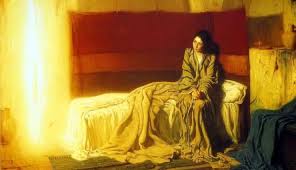Henry Ossawa Tanner (1859-1937), Annunciation
Mount Calvary
A Roman Catholic Parish
The Personal Ordinariate of S. Peter
Eutaw Street and Madison Avenue
Baltimore, Maryland
Rev. Albert Scharbach, Pastor
Andrew Johnson, Organist and Music Director
Advent IV
December 20, 2020
8:00 A.M. Said Mass
10:00 A.M. Sung Mass
This mass will be livestreamed
__________________
Organ Prelude
“Sonata III: Andante tranquillo” Felix Mendelssohn
Organ Postlude
“Sonata III: Con moto maestoso” Mendelssohn
Mendelssohn (1809-1847) was responsible for reviving the music of J.S. Bach in the 19th century. The second movement of this sonata is a brief yet tender, “Andante tranquillo,” while the opening of the first movement, “Con moto maestoso,” makes for a grand and joyful postlude.
_________________
Anthems
Offertory Anthem
“Of the Father’s love begotten,” Erik Spangler
Of the Father’s love begotten, Ere the worlds began to be,
He is Alpha and Omega, He is the source, the ending He,
Of the things that are and have been, and that future years may see,
Evermore and evermore.
This is He whom they in old time chanted of with one accord,
Whom the voices of the prophets promised in their faithful word;
Now He shines, the long-expected; Let creation praise its Lord,
Evermore and evermore.
O ye heights of heav’n adore Him; Angel hosts, His praises sing:
All dominions bow before Him, and extol our Lord and King.
Let no tongue on earth be silent, ev’ry voice in concert ring,
Evermore and evermore.
Christ, to Thee, with God the Father and, with Holy Ghosts, to Thee,
Hymn and chant, and high thanksgiving, and unwearied praises be;
Honor, glory, and dominion, and eternal victory,
Evermore and evermore.
A note from our composer: “Of the Father’s love begotten” marks a return to liturgical composition for the Mount Calvary Choir, after a hiatus of several years. As with my earlier compositions for the choir, the harmonic language is indebted to early music of the Medieval and Renaissance periods, as well as 20th-century approaches to dissonance within an established mode. The form follows a general hymn structure, marked by the refrain of “Evermore and evermore!” at the end of each verse. The number of voices expands from three to four, reduced to two, and then built back up to four voices as a culmination of energy for the final verse. -Erik Spangler
__________
Communion Anthem
“Ave Maria” Jacques Arcadelt
Ave Maria, gratia plena,
Dominus tecum,
benedicta tu in mulieribus,
et benedictus fructus ventris tui, Jesus.
Sancta Maria, ora pro nobis.
Amen.
Hail Mary, full of grace,
the Lord is with thee,
blessed art thou among women,
and blessed is the fruit of thy womb, Jesus.
Holy Mary, pray for us.
Amen.
Arcadelt (1507-1568) was among the first generation of Italian madrigal composers in the 16th century. The clarity and smoothness of his vocal writing is also heard here in his sacred music.
__________________
Hymns
O Come, O Come Emmanuel is a translation of the Latin hymn Veni veni Emmanuel, which in turn is based on the seven O Antiphons, which are sung in the monastic office at the Magnificat on the days preceding Christmas. These antiphons are of ancient origin, dating back to at least the ninth century. The hymn itself, though, is much more recent. Its first appeared in the 18th century. It is interesting to note that the initial words of the actual antiphons in reverse order form an acrostic: O Emmanuel, O Rex, O Oriens, O Clavis, O Radix (“virgula” in the hymn), O Adonai, O Sapientia. ERO CRAS can be loosely translated as “I will be there tomorrow”.
__________
Creator of the stars of light is a translation by John Mason Neale (1818–1866) of the 9th century Creator alme siderum. The translation captures the essence of the original Latin. Contrasting “everlasting light” with the “stars of night” in the first stanza is a common theological theme of Latin hymns. Stanza two refers to the great New Testament hymn found in Philippians 2:10-11: “That at the name of Jesus every knee should bow, of things in heaven, and things in earth, and things under the earth; And that every tongue should confess that Jesus Christ is Lord, to the glory of God the Father.”
